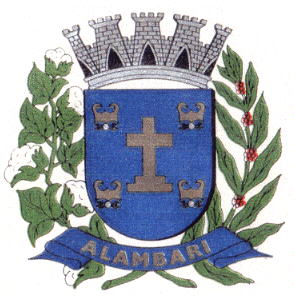Alambari: Difference between revisions
Jump to navigation
Jump to search
Knorrepoes (talk | contribs) m (Text replacement - "|'''English''' ↵| {{blazon wanted}}" to "|'''English''' | blazon wanted") |
Knorrepoes (talk | contribs) m (Text replacement - "↵↵'''" to "'''") Tags: Mobile edit Mobile web edit |
||
| (2 intermediate revisions by the same user not shown) | |||
| Line 1: | Line 1: | ||
'''ALAMBARI''' | '''ALAMBARI''' | ||
| Line 11: | Line 9: | ||
|- | |- | ||
|'''Portuguese''' | |'''Portuguese''' | ||
| | | blazon wanted | ||
|- | |- | ||
|'''English''' | |'''English''' | ||
| Line 22: | Line 20: | ||
The cross indicates the first church built in the area, which was the starting point of settlement. Flint and steel alludes to the abundance of flint stones in the area, once the wealth of the city. | The cross indicates the first church built in the area, which was the starting point of settlement. Flint and steel alludes to the abundance of flint stones in the area, once the wealth of the city. | ||
The supporters symbolise the two main agricultural crops in the municipality, coffee and cotton. | The supporters symbolise the two main agricultural crops in the municipality, coffee and cotton.'''[[Literature]]''': | ||
'''[[Literature]]''': | |||
{{media}} Image and background provided by Lauro Ribeiro Escobar, São Paulo. | {{media}} Image and background provided by Lauro Ribeiro Escobar, São Paulo. | ||
Latest revision as of 13:43, 29 January 2024
ALAMBARI
State : São Paulo
| Portuguese | blazon wanted |
| English | blazon wanted |
Origin/meaning
The arms were granted on June 25, 1993.
The cross indicates the first church built in the area, which was the starting point of settlement. Flint and steel alludes to the abundance of flint stones in the area, once the wealth of the city.
The supporters symbolise the two main agricultural crops in the municipality, coffee and cotton.Literature:
Contact and Support
Partners:
Your logo here ?
Contact us
© since 1995, Heraldry of the World, Ralf Hartemink 
Index of the site Image and background provided by Lauro Ribeiro Escobar, São Paulo.










